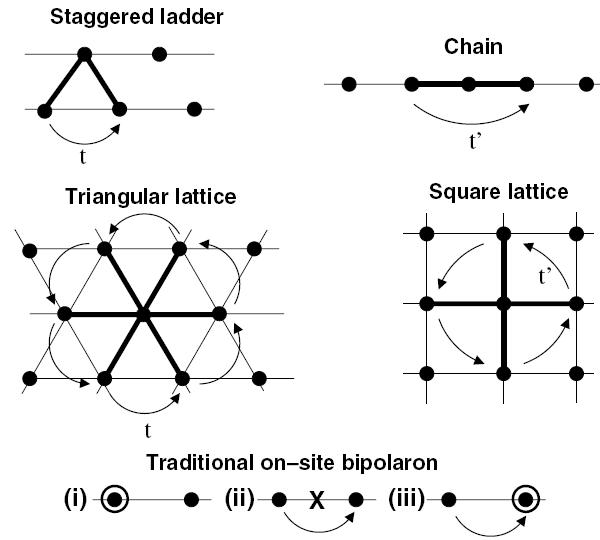 There are many oxides that have interesting properties. For example,
the collosal magnetoresistance manganites and the cuprate
superconductors. Oxide compounds are often have very strong Coulomb
repulsion between electrons, and can have strong electron-phonon
interactions. The figure shows the structure of YBCO, which is a high
temperature superconductor. I have worked on understanding how
electron-phonon interactions can lead to unconventional
superconductivity, and on the transitions between metallic and
insulating behaviour in strongly correlated materials. Investigation
of these phenomena involves the application of many-body quantum
theory.
There are many oxides that have interesting properties. For example,
the collosal magnetoresistance manganites and the cuprate
superconductors. Oxide compounds are often have very strong Coulomb
repulsion between electrons, and can have strong electron-phonon
interactions. The figure shows the structure of YBCO, which is a high
temperature superconductor. I have worked on understanding how
electron-phonon interactions can lead to unconventional
superconductivity, and on the transitions between metallic and
insulating behaviour in strongly correlated materials. Investigation
of these phenomena involves the application of many-body quantum
theory.
Electron-phonon interactions and superconductivity
My main contribution to this field is the development of an extended Migdal-Eliashberg technique which includes vertex corrections and spatial fluctuations. In particular, I showed how vertex corrections are essential to describe the quasi-2D normal state of the Holstein model. In particular, a kink reminiscent to that in the Cuprates is seen, which is best attributed to higher order corrections. I have also extended the theory of superconductivity to quasi-2D. This is closely related to the subject of my PhD thesis (Tuning correlation effects with electron-phonon interactions, and breakdown of Migdal-Eliashberg theory). The most recent result from this project have shown that a d-wave state can be induced from the vertex corrections.
Recently, we carried out variational Monte Carlo simulations which demonstrated the stability of a d-wave state in a Hubbard-Froehlich model.- Superconductivity in a Hubbard-Froehlich model and in cuprates.
T.M. Hardy, J.P. Hague, J.H.Samson and A.S. Alexandrov.
Phys. Rev. B 79 (2009) 212501 (4 pages)
[arXiv:0806.2810] [pdf] - d-wave superconductivity from electron phonon interactions. J.P.Hague Phys. Rev. B 73 (2006) 060503(R) (4 pages, rapid communication) [pdf]
- Electron and phonon dispersions of the two dimensional Holstein model: Effects of vertex and non-local corrections. J.P.Hague. J. Phys.: Condens. Matter 15, pp2535-2550 (2003) [arXiv]
Superconductors have some incredible properties, such as magnetic levitation


Superlight small bipolarons
I also collaborate with Pavel Kornilovitch, Sasha Alexandrov and John Samson on continuous time quantum Monte-Carlo calculations of polarons and bipolarons (including the Holstein and lattice Froehlich models). We have discussed the effects of lattice geometry on polaron properties. We are now simulating bipolarons, and have concentrated on the search for super-light bipolarons in the presence of strong coulomb repulsion and for bound states with angular momentum
. Recently, we investigated the effects of impurities on polarons.
Superlight small bipolarons should be stable on a variety of lattices
- Bipolarons from long range interactions: Singlet and triplet pairs in the screened Hubbard-Froehlich model on the chain.
J.P. Hague and P.E.Kornilovitch.
Phys. Rev. B, 80 (2009) 054301 (20 pages)
[arXiv:0904.3678] [pdf] - Trapping of lattice polarons by impurities
J.P.Hague, P.E.Kornilovitch and A.S.Alexandrov
Phys. Rev. B 78 (2008) 092302 (4 pages)
[arXiv:0805.2556] [pdf] - Superlight small bipolarons in the presence of strong Coulomb repulsion. J.P.Hague, P.E.Kornilovitch, J.H.Samson and A.S.Alexandrov. Phys. Rev. Lett. 98 (2007) 037002 (4 pages) [pdf]
- Effects of lattice geometry and interaction range on polaron dynamics J.P.Hague, P.E.Kornilovitch, A.S.Alexandrov and J.H.Samson Phys. Rev. B 73 054303 (2006) (cond-mat/0509059) [pdf]
- Superlight small bipolarons. J.P.Hague, P.E.Kornilovitch, J.H.Samson and A.S.Alexandrov. J. Phys.: Condens. Matter 19 (2007) 255214 (26 pages) [arXiv]
Hubbard models and strong electronic correlation
Hubbard models are the standard for the study of electronic correlation. Behaviour includes a Mott transition at half-filling, antiferromagnetism, spin-charge separation, and possibly superconductivity. Often the single band model is studied, and is a good test bed for new techniques. However, what happens beyond the simplified one-band case is debated. I have studied the two-band model to investigate the differences with the one-band model. In particular, the Mott transition at half-filling is suppressed, leading to a critical coupling which is nearly 8 times larger than that required to open a gap in the one band model. This casts doubt on the existence of Mott insulators in real materials, instead suggesting that very strongly correlated band insulators, or charge transfer gap insulators should be the most common types of insulator.
- Suppression of Mott-Hubbard states and metal-insulator transitions in the two band Hubbard model. J.P.Hague J. Phys: Condens. Matter. 17, pp1385-1397 (2005) (13 pages) [arXiv]
- Fluctuation-exchange supplemented quantum Monte-Carlo approach to the Hubbard model. J.P.Hague, M.Jarrell and T.C.Schulthess. Phys. Rev. B 69, 165113 (2004). (8 pages) [pdf]